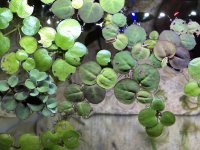brhau
Member
Hello,
In this tank, I have red root floaters, Salvinia cucullata and Amazon frogbit as my floaters. I'm seeing holes in some of the plants (picture below). Does this look to you like:
1. lensing?
2. nutrient deficiency?
3. inverts feeding?
This is a newish tank, so not many snails. It does have amano shrimp. It gets fed:
Flourish (micros)
Fe-DTPA 0.5ppm
potassium 6ppm
nitrogen 2ppm
I do keep a lid on it, since I've got potential jumpers.
Cheers,
Ben

In this tank, I have red root floaters, Salvinia cucullata and Amazon frogbit as my floaters. I'm seeing holes in some of the plants (picture below). Does this look to you like:
1. lensing?
2. nutrient deficiency?
3. inverts feeding?
This is a newish tank, so not many snails. It does have amano shrimp. It gets fed:
Flourish (micros)
Fe-DTPA 0.5ppm
potassium 6ppm
nitrogen 2ppm
I do keep a lid on it, since I've got potential jumpers.
Cheers,
Ben




